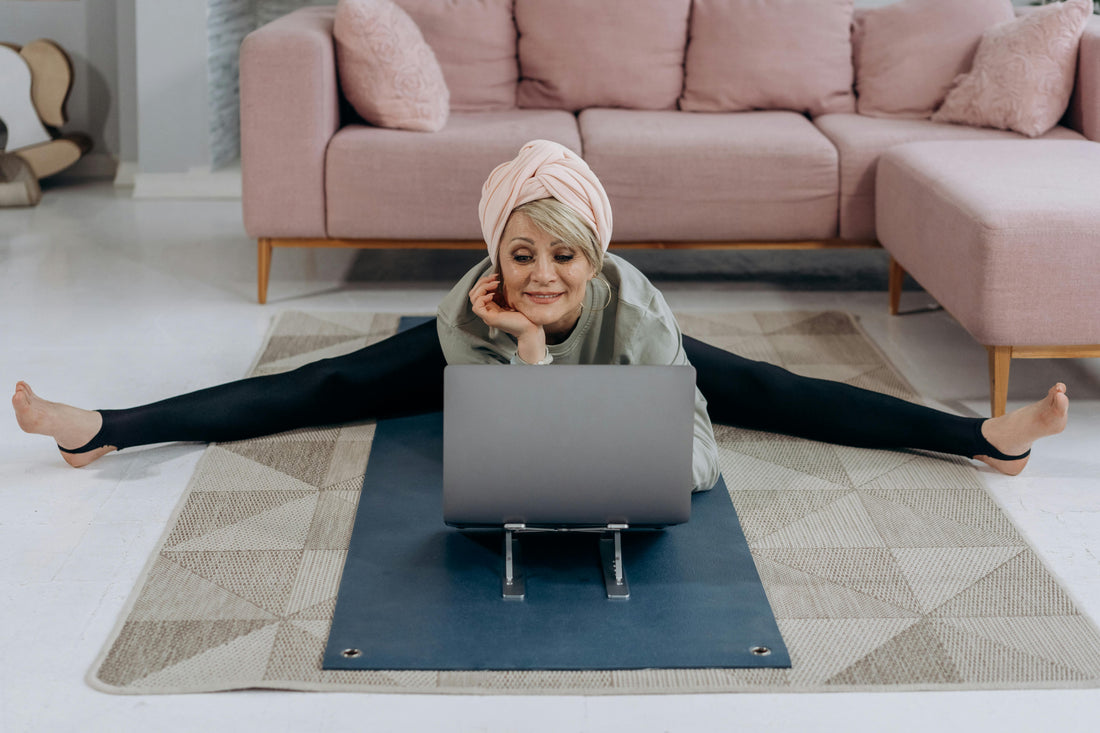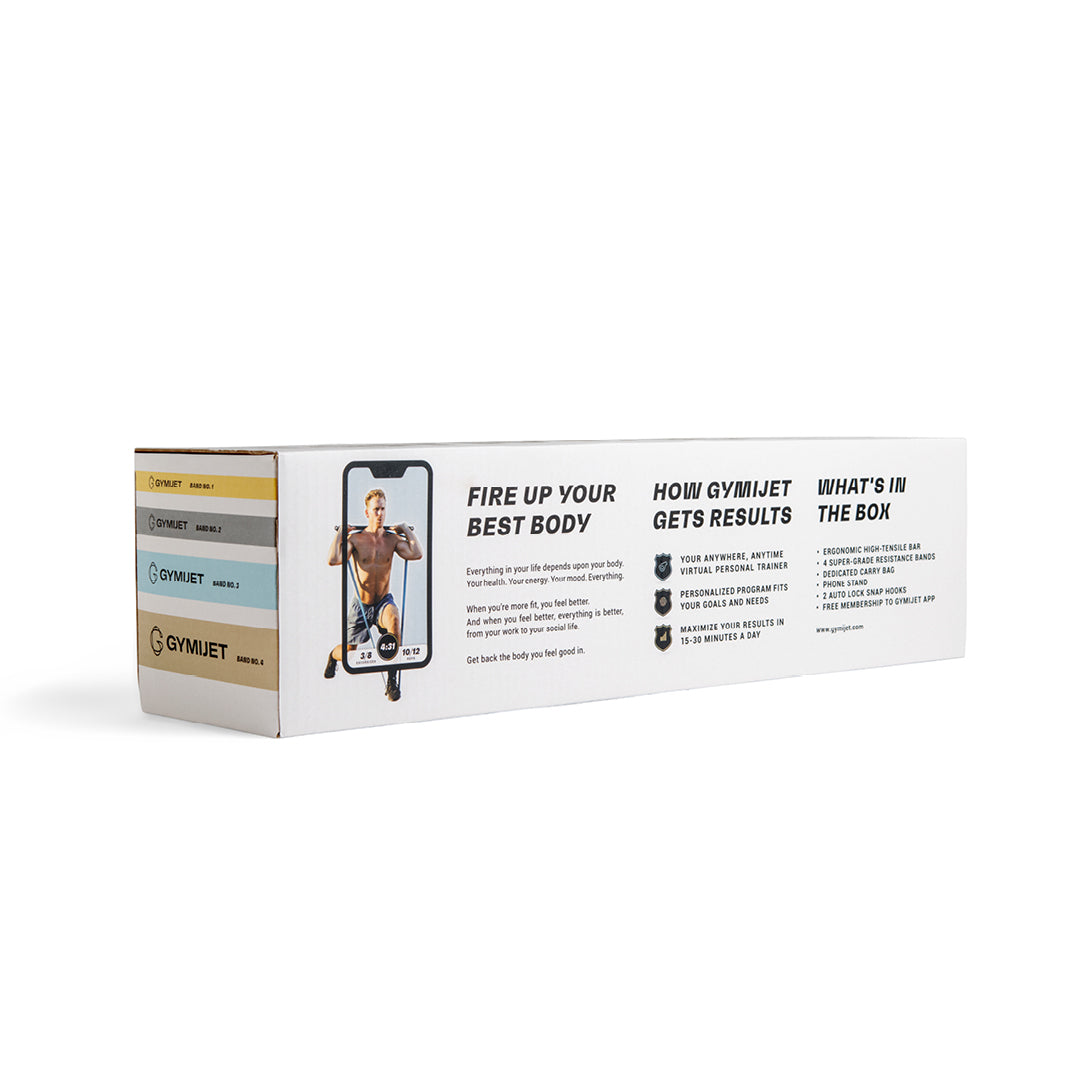
Work From Home Fitness: Combating Sitting Fatigue
Share
Your makeshift home office seemed like a temporary solution when remote work first began. Now, months or years later, that dining room chair is wreaking havoc on your back, your shoulders feel like concrete, and you can't remember the last time you made it through an afternoon without reaching for another coffee to fight the fatigue. Your Fitbit mocks you with daily step counts that barely crack four digits, and standing up after a long Zoom meeting feels like you're 20 years older than you actually are.
The statistics paint a sobering picture of our new working reality. Research indicates that approximately 41% of remote workers report lower back pain, and 23.5% experience neck pain, conditions linked to the increased sedentary nature of remote work and often poor home workstation ergonomics.
Adults in the U.S. now sit for an average of between 9.5 and 10.5 hours daily, significantly more than the 60% of waking hours often cited as the average. Remote workers tend to sit even longer due to the lack of commuting and incidental movement. Without structured breaks or the natural physical activity embedded in an office environment, remote workers face higher risks of musculoskeletal pain and related health issues.
But sitting disease doesn't have to be an inevitable consequence of remote work. Strategic movement breaks, targeted exercises, and smarter workspace habits can help reverse the damage and leave you feeling energized rather than depleted by the end of your workday.
The Challenge: Why Sitting Has Become So Dangerous
Prolonged sitting triggers a cascade of physiological changes that extend far beyond simple discomfort. When you sit for extended periods, your body's metabolism slows dramatically. Research shows that for every two-hour increment in sitting time, the risk of obesity increases by 5% and the risk of diabetes by 7%. This happens because sitting reduces muscle activity to near-zero levels, causing your body's ability to regulate blood sugar and break down fat to plummet.
Cardiovascular health suffers significantly from prolonged periods of sedentary behavior. Recent studies reveal that more than 10.6 hours of sedentary behavior daily significantly increases the risk of heart failure and cardiovascular death, even among people who exercise regularly. The blood flow restrictions caused by sitting create conditions that favor the formation of blood clots, particularly in leg veins, while simultaneously reducing the body's production of nitric oxide, which normally helps blood vessels dilate.
Musculoskeletal problems compound quickly in home office environments. Without proper ergonomic furniture, most remote workers develop what specialists call "Upper Cross Syndrome." This is a pattern of muscle imbalances where the chest muscles tighten while the upper back muscles weaken, resulting in rounded shoulders and a forward head posture. Lower Cross Syndrome follows a similar pattern in the hips and lower back, characterized by tight hip flexors and weak glute muscles, which can lead to chronic low back pain.
Mental performance and mood deteriorate alongside physical health. The lack of movement reduces oxygen flow to the brain while simultaneously increasing cortisol levels, leaving you feeling mentally foggy and emotionally drained by the end of your workday.
Practical Solutions: Building Movement Into Your Work-From-Home Day
Implement the "Movement Snacking" approach throughout your day. Rather than trying to fit one long workout into a single session, break it down into small, frequent chunks. Stand up and perform 10 bodyweight squats every hour. Do 30 seconds of desk push-ups after every Zoom call. Walk while taking phone calls. These micro-sessions accumulate to provide significant health benefits without disrupting workflow.
Set up movement triggers tied to existing work habits. Every time you send an email, take a moment to stand up and stretch. After completing a task, do a quick lap around your home. Following this "habit stacking" approach creates automatic movement patterns that don't require willpower or remembering to set alarms.
Create a dedicated "movement corner" in your workspace. Keep resistance bands, a yoga mat, or light weights visible and accessible. Studies show that environmental design significantly influences behavior—when exercise equipment is in sight, you're far more likely to use it during breaks.
Alternate between sitting and standing positions. Research indicates that office workers who reduce sitting time by incorporating standing periods see improvements in blood sugar levels and reduced back pain. Even 30-second "microbreaks" where you simply stand and arch your back can relieve pressure on spinal discs.
Schedule three strategic movement breaks daily. A morning activation routine (5-10 minutes of dynamic stretches and light cardio), a midday energy boost (15 minutes of strength exercises), and an evening wind-down (stretching and mobility work). These structured sessions ensure you receive adequate movement, regardless of how busy your workday becomes.
Focus on exercises that counteract the effects of sitting in a poor posture. Hip flexor stretches, chest openers, thoracic spine extensions, and glute activation exercises specifically target the muscle imbalances created by prolonged sitting. Incorporate these movements into your breaks to directly combat the physical stress of desk work.
How Gymijet Solves This Problem
Gymijet transforms your workspace into a functional fitness environment, eliminating the need to clear furniture or dedicate a separate room to exercise equipment. The compact 6-pound system fits under your desk or in a drawer, ready to deploy during any work break without the friction of setting up traditional equipment or changing clothes.
The AI technology understands the realities of remote work. It can suggest 15-minute energizing movement breaks during lunch or between meetings—the absolute minimum for maintaining your health—or 30-minute comprehensive routines at the end of your workday for optimal results. The system recognizes your schedule patterns and recommends ideal timing for these essential movement sessions that fit seamlessly into your day without disrupting your productivity.
Targets sitting-specific muscle imbalances. Gymijet's programming includes exercises specifically designed to counteract the effects of prolonged sitting, such as hip flexor work, thoracic spine mobility, glute activation, and core strengthening. The AI ensures you're addressing the exact areas that suffer most from desk work.
Eliminates noise concerns in shared living spaces. Unlike jumping jacks or running in place, resistance training with Gymijet produces minimal sound. This makes it perfect for apartment living, homes with sleeping children, or any situation where you need an effective workout without disturbing others.
Provides accountability through tracking and consistency. The AI monitors your movement patterns throughout the week, suggesting optimal times for exercise based on your typical work schedule. It celebrates consistency streaks and gently nudges you toward your movement goals without feeling like another taskmaster in your already demanding day.
Scales from quick desk breaks to full workouts. Whether you have 15 minutes between meetings or a full lunch hour, Gymijet adapts to provide exercise intensity and duration that are appropriate for you. This flexibility ensures you can maintain consistency regardless of how unpredictable your remote work schedule becomes.
Expert Tips: Professional Insights for Remote Worker Fitness Success
- 60-75 Minutes Daily Exercise Counteracts 8 Hours of Sitting - Meta-analysis research examining over one million adults found that moderate-intensity exercise, equivalent to walking at 3.5 mph or biking at 10 mph for 60-75 minutes daily, effectively counteracts the negative health effects of 8 hours of sitting, emphasizing the importance of dedicated movement time for remote workers.
- Standing Desks Alone Don't Improve Heart Health - Australian research on over 83,000 participants found that prolonged standing doesn't improve cardiovascular health and may actually increase circulatory problems. The key is alternating between sitting, standing, and movement. For example, standing desks are most effective when combined with regular walking breaks and position changes.
- Movement Breaks Reduce Discomfort Without Compromising Productivity - Workplace intervention studies demonstrate that rest breaks incorporating stretches and light exercises minimize musculoskeletal discomfort while maintaining or even improving work performance. Workers report better moods and higher productivity on days they exercise.
- Sitting for over 10.6 Hours Daily Increases Heart Failure Risk - Research published in 2024 by JACC found that sedentary behavior exceeding 10.6 hours per day significantly increases the risk of heart failure and cardiovascular death, even among individuals who meet the recommended exercise guidelines. This highlights that movement throughout the day matters as much as dedicated exercise.
- Ergonomic Modifications Reduce Pain for Only 2-4 Months - A PMC randomized controlled trial demonstrated that adjusting desk height, chair position, and monitor placement initially reduces musculoskeletal discomfort. However, the effectiveness diminishes after 2 months without ongoing exercise, highlighting that ergonomics alone cannot resolve sitting-related health issues.
- Office Design Promoting Movement Has Greater Impact Than Sit-Stand Desks - A systematic review of physical work environments found that building features encouraging incidental activity, such as centralized facilities, staircases, and shared workspaces, increased physical activity more effectively than individual sit-stand desk interventions, suggesting that environmental design plays a significant role.
- Each Daily Minute of High-Intensity Exercise Lowers Obesity Risk - Cleveland Clinic research demonstrates that even brief periods (under 10 minutes) of higher-intensity physical activity throughout the workday positively affect weight management, with each minute of vigorous exercise lowering the risk of obesity in sedentary workers.
FAQs
How often should I take movement breaks during my workday?
Aim to stand up and move at least once per hour, with a minimum of 30 seconds to 2 minutes of activity. Research shows that even these brief interruptions to sitting significantly reduce health risks. Ideally, incorporate three longer structured breaks (5-15 minutes) spread throughout your day for more comprehensive movement.
Can short desk exercises really make a difference?
Absolutely. Studies show that "movement snacking" or brief exercise sessions totaling 10-15 minutes daily, spread throughout your workday, provides measurable cardiovascular and metabolic benefits. The key is consistency and breaking up prolonged sitting, not necessarily the duration of each session.
What are the best exercises for combating sitting posture?
Focus on hip flexor stretches, chest openers, thoracic spine extensions, and glute bridges. These movements directly counteract the muscle imbalances created by sitting. Cat-cow stretches, shoulder blade squeezes, and neck rotations are also highly effective for relieving tension from desk work.
Will a standing desk help alleviate my back pain?
Standing desks are helpful, but they are not a complete solution. Research shows they reduce sitting time but don't significantly increase overall physical activity or improve heart health. The best approach combines sitting, standing, and regular movement breaks, alternating positions every 30-60 minutes while incorporating walks and exercises.
How can I stay consistent with desk exercises when work gets busy?
Tie exercises to existing work habits using "habit stacking." Do squats after every Zoom call, stretch while code compiles, or walk during phone calls. Setting phone alarms for hourly movement reminders also helps, but habit-stacking creates more automatic and sustainable patterns.
Work From Home With Gymijet
Remote work doesn't have to mean accepting chronic pain, fatigue, and declining health. By recognizing that prolonged sitting is both detrimental and unavoidable in modern work environments, you can take strategic measures to protect your body and maintain energy throughout your workday. The solution is integrating movement into the structure of your existing schedule.
Research consistently shows that frequent, brief movement breaks offer more benefits than occasional longer workouts in counteracting sedentary behavior. Your body needs regular stimulation throughout the day, not just one compensatory gym session. By moving a seamless part of your work routine rather than an additional burden, you can transform how you feel by the end of each workday.
Ready to reclaim your energy and eliminate sitting fatigue? Start Your Work-From-Home Fitness Journey with Gymijet Today and discover how quick, effective resistance workouts can keep you strong, pain-free, and productive without leaving your home office.














